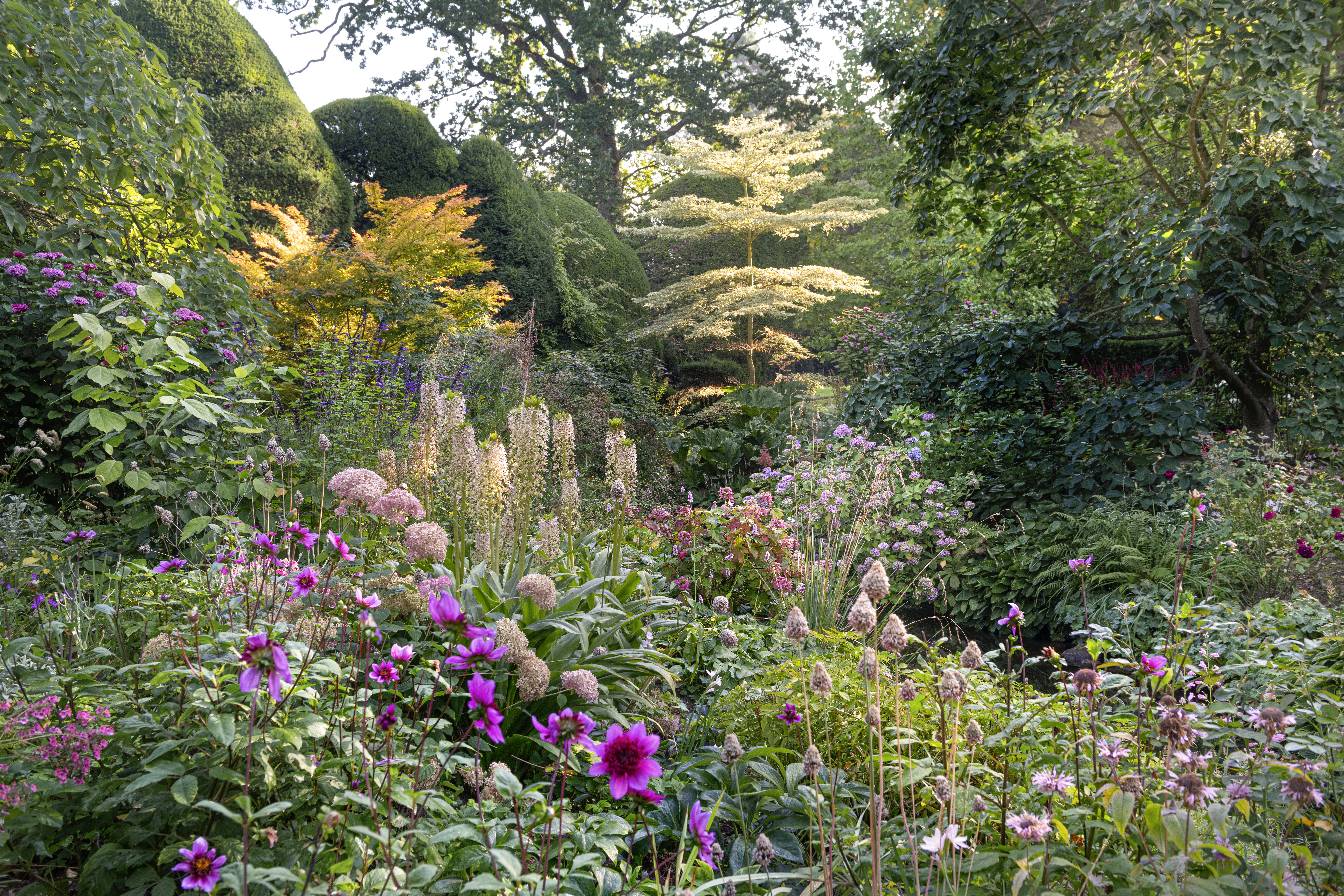Ahead of celebrating the book launch of ‘Melbourne Hall Garden’ on Tuesday 30 September (book tickets), we are pleased to share this exclusive extract on how the Georgian gardens are being revived for twenty-first century tastes:
‘Tending and extending this garden has been like painting a picture that changes every day – in fact it sometimes feels like someone else secretly adds bits to it in the middle of the night,’ Marie-Claire Agnew.
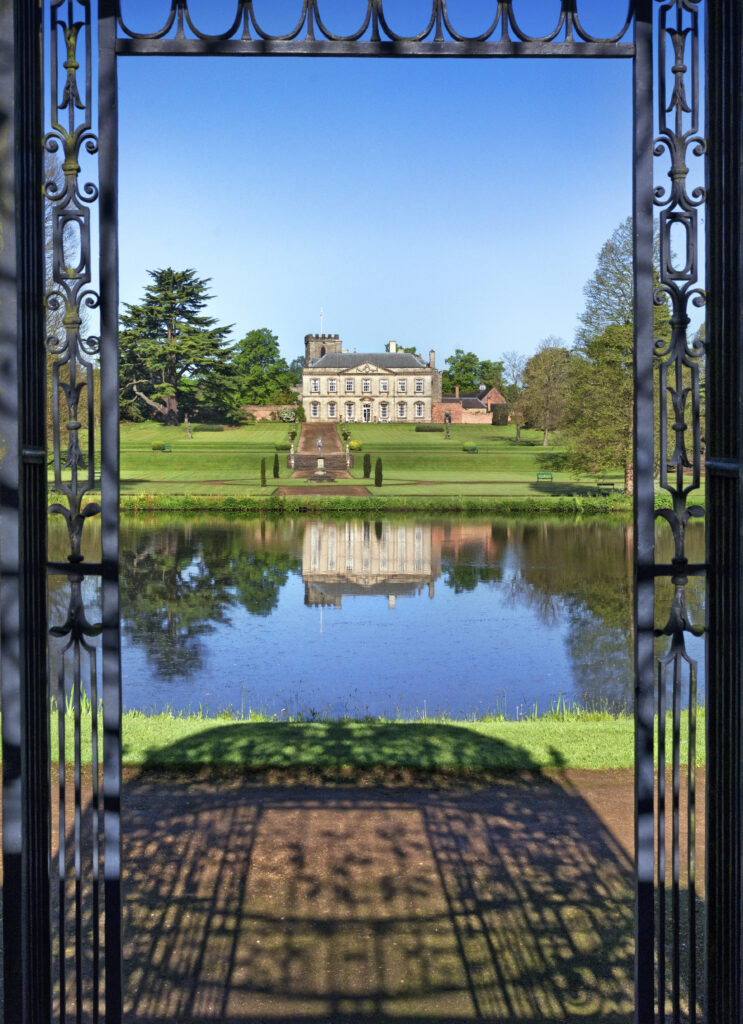
When Marie-Claire moved to Melbourne Hall she found herself living in a garden that was unquestionably beautiful, but botanically rather lacking in interest and coloured predominantly in different shades of green. As an artist, she craved a more varied palette and a space away from the perfectly staged, formal heart of the garden where she could create something new.
She found the perfect location beyond the south side of the Yew Tunnel, where the ancient millstream flowed, although at that time sections of it were almost completely hidden from sight by a mass of self-sown holly, sycamore and rhododendron (Rhododendron ponticum).
As soon as the site was cleared, she set to work on the rich damp soil, first creating a Bog Garden in the dappled shade of some statuesquely beautiful overhanging trees. She was just twenty-five years old and, although she had been fortunate enough to grow up surrounded by wonderful plants, she had no first-hand experience of combining them to create a whole new garden.
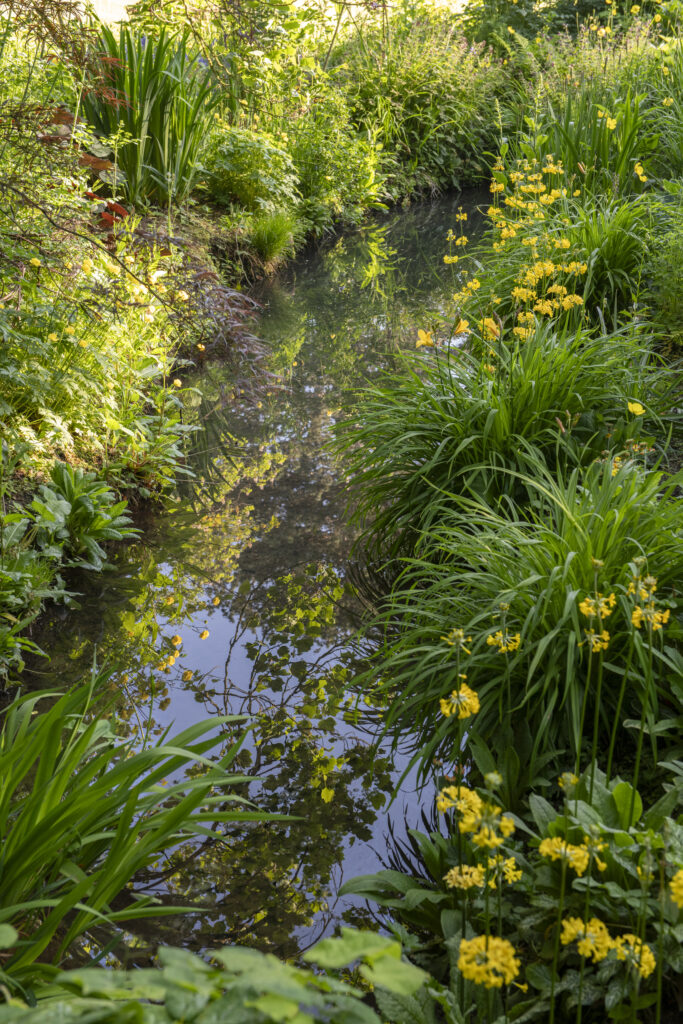
‘In the early days I was hugely helped and guided by Robert Vernon and, particularly on the herbaceous side, by his wonderful wife Suzette. I still managed to make so many mistakes to start off with, but I was driven by passion. Initially I was drawn to all the beautiful spring-interest flowers, from rhododendrons to candelabra primulas. Some, like my first Rhododendron macabeanum, I put in the wrong place, where it completely failed to thrive until I realized and moved it.
With the candelabra primulas, I let my collector’s enthusiasm get the better of me and initially put far too many different colours together. As I have grown older and more experienced, I have realized that simplicity is usually the key to a successful scheme.’
With her innate understanding of colour honed by years of artistic training and professional painting, Marie-Claire decided upon a spring-fresh combination of yellow and blue in the Bog Garden. Elegant Cockburnia primroses and other candelabra forms were visually enhanced by vivid ‘Blue Heron’ corydalis, while lime-green hostas perfectly set off the blue Meconopsis poppies that she had first come to love as a child in Scotland.
Into the mix she added a handkerchief tree (Davidia involucrata) and a paperbark maple (Acer griseum), visualizing how the cinnamon tones of the acer would enhance the overall picture in the years to come. Around the adjacent grotto, she set a dainty little white rose scrambling over the roof and let Turk’s cap lilies self-seed at the skirt of a cushiony mound of the round-leaved Rhododendron williamsianum.
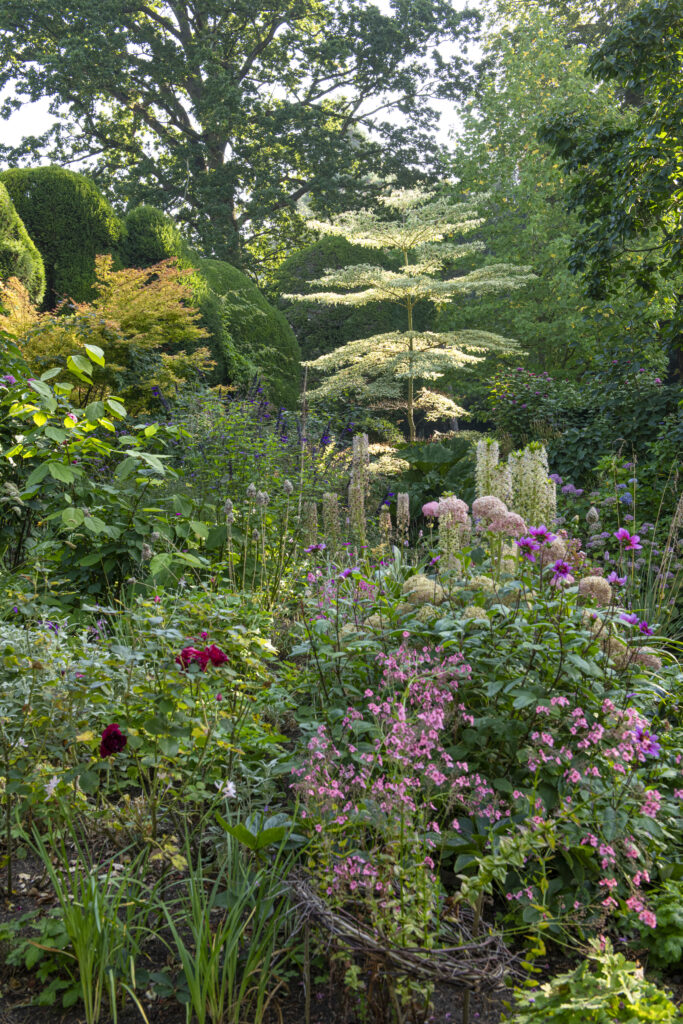
Once she started, Marie-Claire found that she couldn’t stop, and next turned her attention to a neighbouring area where the light levels were higher and the ground a little drier. Here she created the Paulownia Border and Long Border in an innovative combination of pale pink and dark red, to which the eponymous Paulownia, or foxglove tree, adds its soft lavender-pink flowers in April, although the display starts much earlier in the year. First there are assembled masses of tulips, in which the cultivar selection is continually refined and revised, then more of Marie-Claire’s beloved primulas. ‘For a time, we had them in too many different colours,’ says Marie-Claire. ‘Now we focus on Primula pulverulenta and other pink forms, which have been chosen to complement the general scheme of dark reds and pale
pinks.’
The herbaceous content builds as the season progresses and includes a wave of ‘flowering’ dogwood (the showy elements are technically bracts). Later in the year there is a rich display of autumn colour from a number of unusual horse chestnuts and katsuras (Cercidiphyllums), among a great deal more besides.
Each species is given its moment to shine, and the picture is continually reassessed.
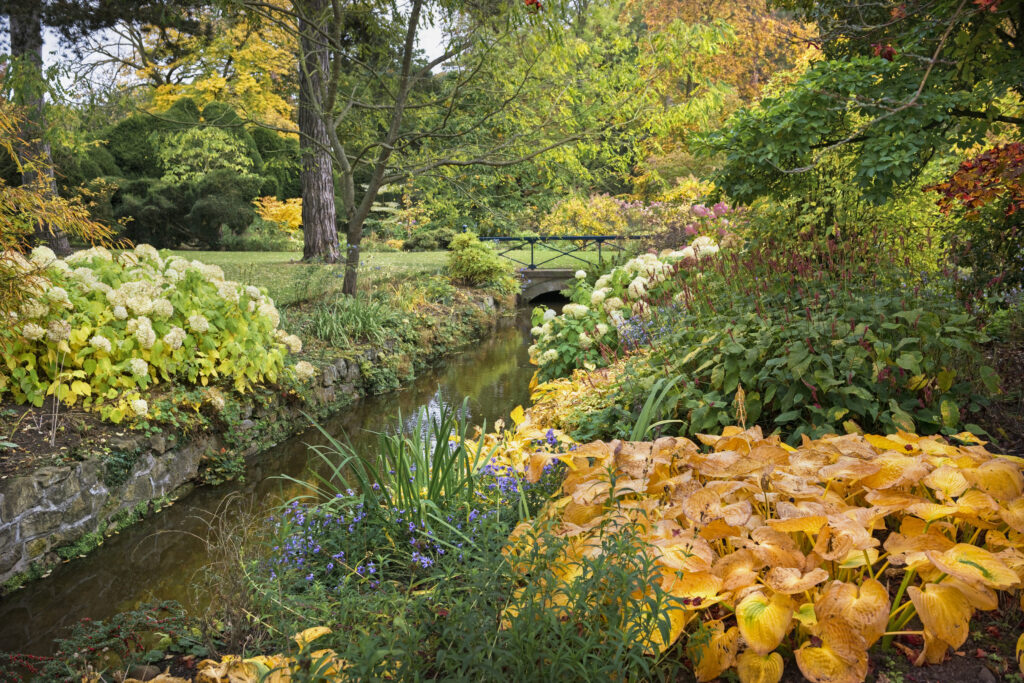
Separated from this richly coloured confection by a broad path of velvety emerald grass, are the Mill Borders, where Marie-Claire has created a hugely romantic picture in sherbet-soft shades of lemon, lilac and lime. Here, the decorative effect is further enhanced by the water of the stream itself, which mirrors the exuberantly planted beds tumbling towards it on both sides.
In general, water is a huge element in these gardens – the gentle sound of the fountains, the dragonflies and damselflies that dart everywhere and the newts, frogs, mussels and little fish that live in the water itself. Now, in spirit at least, the Mill Borders recall that other artist’s water garden, at Giverny, where Monet planted and painted his waterlilies. At Melbourne Hall, the millstream runs too fast for waterlilies, but the masses of ‘Annabelle’ hydrangeas, lush clumps of hosta and trailing stems of rambling roses create a reflective picture that is every bit as magical. There are also swathes of an unnamed but very beautiful palest-lavender iris that has become something of a Melbourne Hall signature plant, in much the same way that the clever use of herbaceous colour has become a signature of the gardens as a whole.
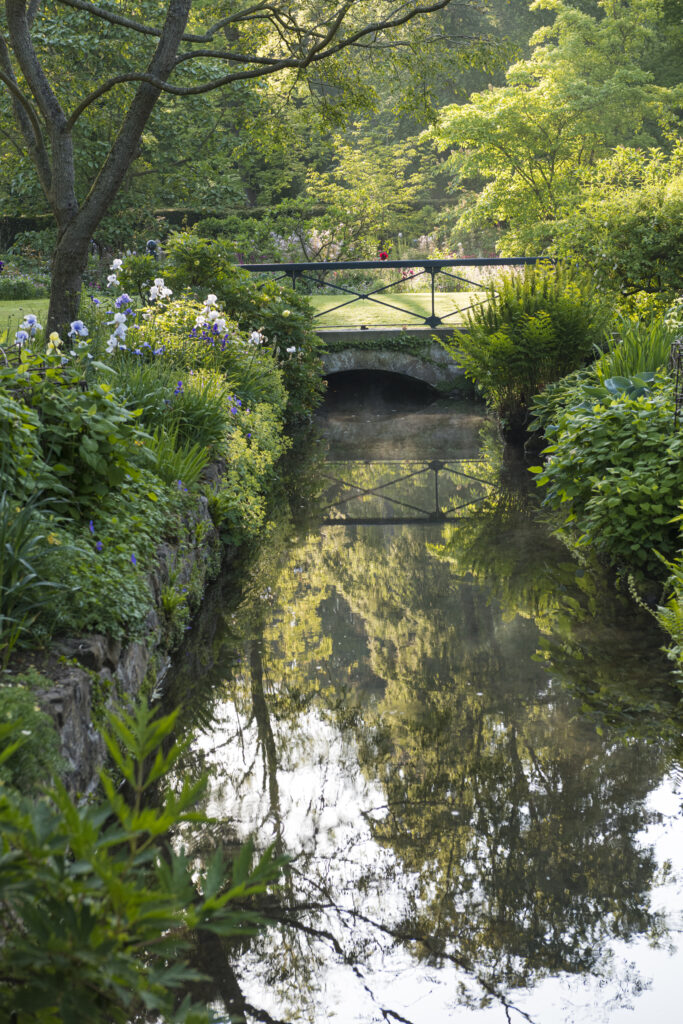
Marie-Claire is always delighted to see visitors photographing and debating the plant combinations in these colourful borders, but this is not the only area where she has focussed her creative talents. Beyond the public gaze she has also created a private space intended solely for her family to use that, unsurprisingly, has been given every bit as much creative consideration as the rest of the garden. Here, behind a metal gate set into an arched gateway, the palette is soft shades of bronze and lemon that complement the warm tones of the brick walls enclosing this intimate space. Foxtail lilies (Eremurus) and the climbing rose ‘The Pilgrim’, towering giant scabeous (Cephalaria gigantea) and a carefully chosen selection of peonies are anchored by sculptural balls of variegated pittosporum and softened with an airy scattering of bronze fennel. The practicalities of life are also catered for. There is a generously proportioned garden table and enough chairs to comfortably seat the entire Kerr clan.
There is also a barbecue, set out in a paved corner next to the house that once contained Lord Melbourne’s dressing room (look carefully at the walls on this corner of the Hall and you will see the remains of a rendered surface, although the walls that once enclosed it were long ago demolished).
This private garden is known as the Peacock Garden, and it serves as a perfect metaphor for the gardens in general and the estate as a whole. The history of the site has been acknowledged, it is respected, but it has also been enhanced and adapted to the needs of the family who currently call this historic property their home.
—
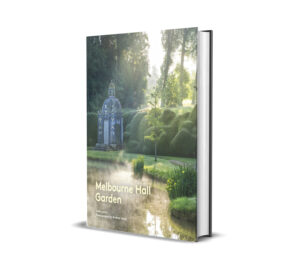
Join us for the launch of Melbourne Hall Garden (published by Frances Lincoln) with author Jodie Jones, photographer Andrea Jones, and chaired by George Plumptre, on Tuesday 30 September: book tickets
